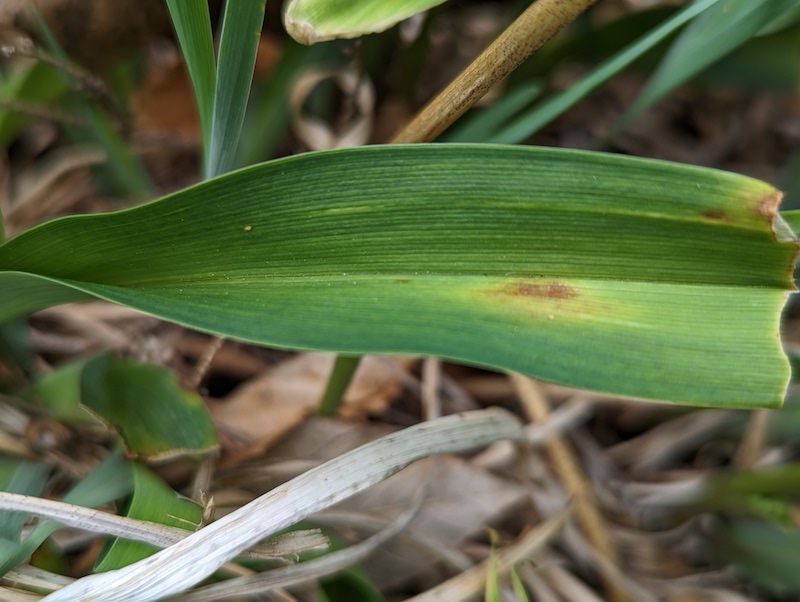Although all iris types and varieties are very low maintenance and easy to care for, there are some diseases to watch out for. While these diseases may be viral (mosaic virus), bacterial (bacterial soft rot), or fungal (Botrytis, fungal rust, iris leaf spot), all of them are common to most ornamental plants and easily controlled by mechanical and cultural techniques. Only in rare cases, chemical controls may be required to control a disease of irises.

Iris Leaf Spot
Iris leaf spot, Cladosporium iridis, is a fungal disease that is easily spread throughout the plant by sporing fungal bodies. Warm, wet weather is conducive for this fungus to infect susceptible plants. Leaf spot also overwinters on the fan-shaped leaves of affected plants and is spread easily by overhead watering of the plants, washing the spores from one plant to another. Mature plants can tolerate infections of iris leaf spot and will regrow healthy foliage either later in the season or in the next year.
Identifying Iris Leaf Spot
Small brown spots appear on the foliage and will eventually grow into large brown or yellow patches. The fungus weakens the foliage and prevents the plant from photosynthesizing efficiently. Affected leaves will eventually fall off the plant and transmit spores to the soil to allow for overwintering and reinfection the next year.
Treating Iris Leaf Spot
Treatment is as easy as practicing good garden hygiene. Remove infected leaves from the plant and pick up and dispose of any fallen leaves. Do not compost infected plant parts. Home compost piles rarely reach high enough temperatures to kill off iris leaf spot fungal spores. Preventative fungal sprays can be used before the leaf spot appears on plants that have been infected in the past. Use a fungicide that is registered to specifically target the iris leaf spot fungus. Always follow all instructions from the manufacturer and understand that reapplication will be necessary, especially in gardening zones that have heavy rainfall during the iris growing season.

Fungal Rust of Iris
Fungal rust of irises (Puccinia iridis) is a common fungus that appears during periods of warm, humid weather and is easily spread from plant to plant. Overhead watering and poor air circulation are the most common ways for this disease to be spread in a garden. Most plants in your garden can develop a fungal rust, although each one is specific to the genus of the plant. For example, onion rust rarely infects iris plants that are growing nearby. Sometimes there may be an alternate host for a fungal rust that can then go on to infect plants of a different genus altogether. Clearing possible vector weeds and grasses from the garden is always a good idea and can protect plants and save the gardener from the extra maintenance of battling an infection.
Identifying Fungal Rust of Iris
Fungal rust is identifiable by the small orange or rust-colored spots that first show up on the leaves of the plant. Over time, the rusty-colored spores spread and make larger patches on the affected leaves. If the rust strikes before the plant flowers, the buds can be infected as well, although flowering may not be affected greatly.
Treating Fungal Rust of Iris
Good garden hygiene is the best defense against iris fungal rust. Dispose of affected leaves in the trash. Do not compost infested foliage. In climates with temperate winters, the spores may successfully overwinter in the soil without the killing frosts of colder climates. Rotation of Iris plants to a part of the garden not affected by fungal rust may help to reduce outbreaks. Fungicides will only protect parts of the plant that do not show signs of spore infection. Use a fungicide that is specifically listed for use on irises, following all manufacturer's instructions. Look for cultivars of iris that have been bred to be rust resistant.
Botrytis
Botrytis is commonly referred to as gray mold and affects ornamental and edible plants alike. Often, Botrytis is a secondary infection affecting damaged parts of the plant such as leaves that have been walked on and crushed or flower buds that have died back from overwatering and left on the plant. This fungus is spread in warm, humid conditions. Mature plants often recover fully if action is taken soon after diagnosis. Seedlings and newly transplanted iris may not have the ability to fully recover and may need to be removed altogether to save other plants.
Identifying Botrytis
Botrytis can appear anywhere on the plant that has had a previous injury. The Botrytis will look like gray or black mold spores, which represent an advanced stage of the disease. Initially, infected areas look like water-soaked patches. The fungus spreads quickly and can affect healthy parts of the plant if not treated.
Treating Botrytis
Mechanical methods of treating Botrytis are usually the most effective. Remove any plant parts that have visible gray mold. If large parts of the plant are infected, the best course of action is to remove the whole plant and dispose of it in the trash. Overhead watering should be avoided during an outbreak. The water droplets can easily transmit Botrytis spores to other parts of the plant and the soil. Soaker hoses and drip irrigation ensure that the rest of the plant and its surrounding neighbors remain spore-free.
Bacterial Soft Rot
Bacterial soft rot, Erwinia carotovora, affects the rhizome and growth crown of irises. A more commonly known term is root rot, which is common in plants that do not tolerate heavy soils and poor drainage. Mostly, this bacterial infection is a secondary issue that enters the plant's tissues through damage caused by slugs, snails, or other mechanical means.
Identifying Bacterial Soft Rot
Bacterial soft rot is easily identified by a dark, mushy appearance on the leaves or roots and the telltale rancid smell of waterlogged soil. Early identification means that the plant is more likely to be saved. If left untreated, plants die as the roots disintegrate.

Treating Bacterial Soft Rot
Cultural methods are the best treatment for bacterial soft rot. Irises demand excellent drainage and rarely do well in soils with heavy clay. Digging up and transplanting the iris to a better location may help save the plant overall. Make sure to cut away any affected parts of the plant before replanting. Properly space plants to provide good air circulation.
Iris Mosaic Virus
Iris Mosaic Virus is often transmitted to plants by aphids, primarily the green peach aphid. Siberian and bearded irises are the most often affected varieties. Commercially, plants that show symptoms of Mosaic Virus cannot be sold and must be destroyed to reduce the chance of the disease spreading to other plants. Irises grown indoors or in cooler temperatures often show more extreme symptoms of the virus. Symptoms are often less noticeable in warmer weather.
Identifying Iris Mosaic Virus
Plants with a Mosaic Virus infection will display yellow striping and stunted growth of foliage or flowers. The flowers may also have unusual color markings, called a color break. Plants will not recover and will continue to decline in vigor if left to grow for another season.
Treating Iris Mosaic Virus
Unfortunately, there is no way to help infected plants recover. The only action that can be taken is to remove the plant and dispose of it in the trash, not your home compost pile. In the future look for plants that are certified as virus-free and resistant. Remove weeds from the garden that could harbor aphids or other sap-sucking pests that act as a vector for this virus.
Iris Disease Chart
|
Disease |
Identifying |
Treating |
|
Iris Leaf Spot |
Yellow or brown dots or spots on foliage that eventually turn into large sections of yellow or brown patches |
Good garden hygiene, avoid overhead watering |
|
Bacterial Soft Rot |
Brown spots on foliage or rhizomes |
Plant at the correct depth, avoid overhead watering, space plants properly to promote air circulation |
|
Botrytis |
Gray or black mold and spores growing on affected foliage and flowers |
Remove infected parts of the plant immediately, reduce watering, space plants properly |
|
Iris Mosaic Virus |
Stippled marks on foliage and unusual colorations of the flowers |
Remove weeds that can act as virus vectors, dispose of plant that is heavily infected |
|
Fungal Rust |
Powdery yellow or rust-colored spots on the foliage |
Avoid overhead watering, remove plants as they become infected |
Sources:
"Iris (Iris)." The Connecticut Agricultural Experiment Station. portal.ct.gov
"Iris Diseases." Royal Horticultural Society. rhs.org.uk
 |
Author Robbin Small - Published 4-19-2023 |
